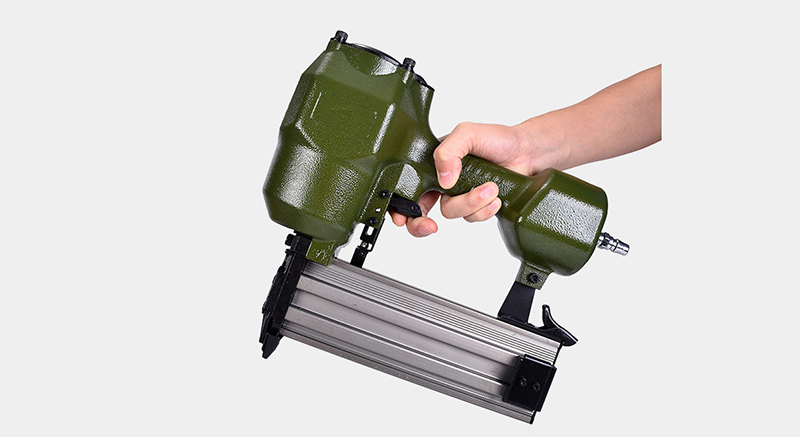Pneumatic Nail Gun: An Efficient Nailing Tool in Professional Construction
Amid the hum of woodworking workshops and on the scaffolding of building renovations, the pneumatic nail gun, with its rapid firing speed and strong penetration, has become an indispensable core tool in modern construction scenarios. This equipment, powered by compressed air, has completely transformed the inefficient traditional manual nailing method, providing a reliable solution for professional operations and precision construction.
I. What is a Pneumatic Nail Gun?
A pneumatic nail gun (also known as a pneumatic stapler) is a professional tool that uses power generated by compressed air to drive a firing pin, quickly shooting rows of nails into materials such as wood, gypsum board, and metal. Unlike manual nail guns that require strenuous operation and electric nail guns with battery life limitations, it has core advantages of "fast speed, strong force, and high durability," making it a standard piece of equipment in fields like woodworking, building decoration, and furniture production.
A complete pneumatic nail gun system consists of two parts. One is the gun body itself, which includes core components such as the gun frame, nail magazine, and trigger mechanism. The other is the power supply system, where an air compressor delivers high-pressure compressed air to the gun body through an air hose. The air compressor is regarded as the "heart" of the entire system. Although this separate design increases the initial investment cost, it professional-level work efficiency.
![Schematic Diagram of Pneumatic Nail Gun System Composition] (Diagram Description: The air compressor is on the left, connected to the gun body on the right through the middle air hose. The three core parts of "air compressor - power source," "air hose - transmission channel," and "gun body - execution mechanism" are labeled)
II. Core Structure and Working Principle
The efficient operation of a pneumatic nail gun relies on a precise internal structure and air pressure control logic. Its core components and workflow can be broken down into the following key links:
1. Analysis of Core Components
2. Step-by-Step Analysis of the Working Principle
![Internal Working Principle Diagram of Pneumatic Nail Gun] (Diagram Description: Components such as "cylinder," "piston," "firing pin," "nail magazine," and "exhaust port" are labeled, and arrows are used to show the complete process of "compressed air entry → piston pushing → firing pin hitting the nail → exhaust and reset")
III. Main Types and Applicable Scenarios
According to the differences in work requirements, pneumatic nail guns can be divided into various types. Different types have their own focuses on nail type adaptation and application scenarios. When choosing, the principle of "task matching" should be followed:
| Nail Gun Type | Adaptable Nail Type | Core Application Scenarios | Construction Key Points |
|---|---|---|---|
| Straight Nail Gun | Straight Nails (Type F) | Furniture assembly, panel splicing, ceiling keel fixing | The air pressure needs to be adjusted to 0.4-0.6MPa to avoid nail bending |
| Staple Gun | Staples (U-shaped) | Wooden box packaging, fabric stretching and nailing, decorative part fixing | Choose stainless steel nails for outdoor or humid environments |
| Steel Nail Gun | Steel Nails | Concrete precast slab, steel structure connection | Safety goggles must be worn to prevent nail rebound |
| Fine Nail Gun | Fine Nails | Decorative lines, thin plate splicing | The nails have strong concealment and are suitable for fine woodworking |
(Data synthesized from)
For example, in the construction of outdoor anti-corrosion wood fences, a pneumatic staple gun adapted to 40-50mm stainless steel staples should be selected. Since wood is prone to cracking, it is necessary to drill holes in advance before nailing to improve the firmness. When installing ceiling keels, 25-32mm straight nails matched with a pneumatic straight nail gun are the best choice. Adjusting the air pressure before construction can avoid the problem that the nails are not fully driven in.
IV. Complete Guide to Selection, Use and Maintenance
1. Key Points for Selection
2. Safety Usage Specifications
3. Daily Maintenance Skills
V. Summary
From manual nailing to the popularization of pneumatic nail guns, the iteration of tools has witnessed the leap of construction efficiency. This professional equipment powered by compressed air has become a "bridge" connecting materials and structures with its strong power and efficient operation ability. Whether it is the assembly line production of furniture factories or the detailed construction of home decoration sites, selecting, using, and maintaining the pneumatic nail gun correctly can not only greatly improve work efficiency but also ensure construction quality and operation safety.



 Send Email
Send Email